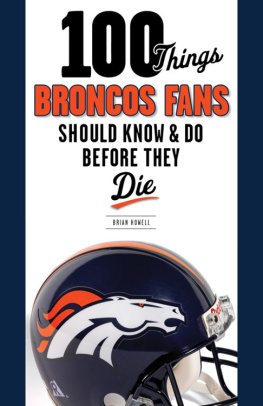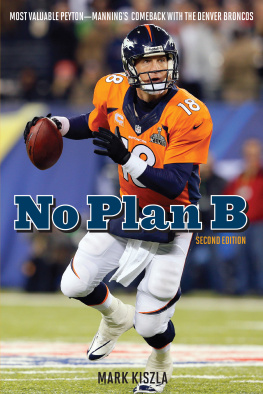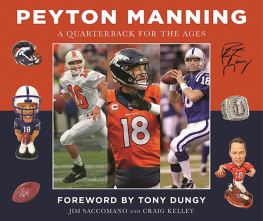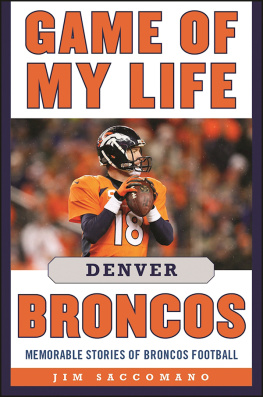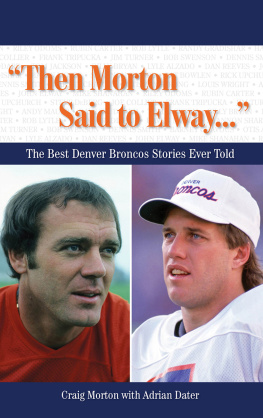Acknowledgments
There was a time when professional football in Denver wasnt so popular, wasnt so lucrative, and wasnt so fun to watch. When Austin Goose Gonsoulin joined the Broncos as a rookie in 1960, he seriously wondered whether there would even be a team in 1961.
More than 50 years later, the Broncos have become one of the model franchises in the National Football League. Although it took a while for them to learn to win, the Broncos eventually figured it out and havent really stopped. Theyve won two Super Bowls and played in six. They have produced four Hall of Fame players (with many more to come). For me, a lifelong fan of the franchise, researching and writing about some of the most memorable players, coaches, games, and seasons in team history was a pure joy.
Many individuals contributed to this book. I am grateful for the insights, stories, and memories provided by former Broncos Billy Thompson, Tom Jackson, Floyd Little, Shannon Sharpe, Goose Gonsoulin, Karl Mecklenburg, Craig Morton, Steve Atwater, Marlin Briscoe, Alfred Williams, and Sammy Winder and former head coach Dan Reeves. Current players Elvis Dumervil, Eric Decker, and David Bruton were gracious with their time as well.
In addition, the memories and opinions of longtime Denver sports talk host Sandy Clough, former Broncos radio broadcaster Larry Zimmer, and Denver Post writer Terry Frei assisted me greatly. The stories of former Denver Gold running back Harry Sydney and Robert Howsam, the son of the Broncos original owner Bob Howsam, helped make this book come alive even more.
Thanks to Broncos public-relations guru Jim Saccomano, whose knowledge of the team is unsurpassed. Thanks also to Broncos executive director of media relations Patrick Smyth and Denver radio personalities Andy Lindahl and Brandon Krisztal, whose assistance in contacting former players was invaluable.
Finally, thanks to my wife Melissa and our children, Connor, Isabel, Lucas, and Mason, who put up with my long hours and late nights at the computer and the library.
8. Sharpe Tongue
In Broncos history, there may not have been a better tight end than Sharpe. He may also hold claim to the most impressive physique and brightest smile in team history.
Loudest mouth? Well, thats no contest.
Thats my personality, Sharpe said.
A seventh-round pick from tiny Savannah State in 1990, Sharpe didnt figure to have much reason to talk when he got to the NFL. But he did anyway.
He always had confidence in himself, said Reeves, who coached Sharpe from 1990 to 1992. He was always fun to be around because he had that big smile and always was the guy that was talking. That became more and more [frequent]; as he became a bigger part of it and he became a better player, you can do more talking.
Sharpe didnt back it up as a rookie, catching just seven passes for 99 yards and one touchdown, but each season he became more integral to the offense. By the time he retired in 2003, he held NFL records for catches (815), receiving yards (10,060), and touchdowns (62) by a tight end. He was elected to the Pro Football Hall of Fame in 2011.
Drafted as a wide receiver, Reeves didnt take long to move the 6'2" , 228-pounder to H-back, a hybrid of a fullback and tight end. He was a mismatch for safeties and linebackers, Reeves said.
The more he grasped the offense, the more the Broncos used those mismatches to their favor.
He was coming into his own as a player when I left there, said Reeves, who was replaced by Wade Phillips and then Shanahan. They did a great job with him in making him the best player he could be.
Although he came from a small college, Sharpe wasnt a total unknown when the Broncos drafted him. His older brother, Sterling, led the NFL with 90 catches in 1989 and, at just 24 years old at the time, had established himself as one of the games elite wide receivers.
Shannon always looked up to Sterling, who went to the University of South Carolina, was a first-round pick (chosen seventh overall in 1988 by Green Bay), and was a five-time Pro Bowler in seven seasons before being forced to retire, at the age of 29, because of a spinal injury.

Hall of Fame tight end Shannon Sharpe sizes up the competition during a 1997 game. Photo courtesy of Getty Images
During his Hall of Fame induction speech in 2011, Shannon said, Im the only pro football player thats in the Hall of Fame [who is also] the second-best player in my own family. If fate had dealt [us] a different hand, there is no question, no question in my mind we would have been the first brothers to be elected to the Hall of Fame.
Shannon came in with good genes and a work ethic unmatched by most. It was a work ethic sparked by his draft position, Sterling said when he presented his brother at the Hall of Fame.
Not getting drafted before the seventh round helped him more than anything or anyone, myself included, because it humbled him, broke him and made him a fierce competitor all at the same time, Sterling said.
Whatever the motivation, Shannons work ethic was well known among his Broncos teammates. He was a guy who was extremely disciplined, and he wanted to be the best, Atwater said. He was the one always leading with the jokes and the pranks, but at the same time when we worked, he was one of the hardest workers out on the field, too.
Hard work played a pivotal role in Sharpes rise, but so did his mouth. From the time he started playing football, trash-talking on the field was a part of his game. He loved facing the Broncos biggest rivals, the Oakland Raiders and Kansas City Chiefs, because that brought some of his best trash-talking.
I did that my whole life, so I didnt really see any need for me to stop once I got to the highest level, because that helped me get to that level, he said. I just felt that I needed to continue to be Shannon.
I felt that besides being a very good player and a hard worker, my job was to keep the guys loose. I didnt want the guys to get too caught up in the moment, the game, and all of a sudden get in awe of the moment. My job was to keep it loose. I kept it loose on the practice field, I kept it loose in games and in the locker room. When the game started, they knew I was going to be ready to play.
Some of his antics, such as wearing a giant Broncos horse head after big wins, endeared him to the fans. Perhaps no incident put Shannons personality on display quite like what he did on November 17, 1996. That afternoon, the Broncos were in Foxborough, Massachusetts, to take on the New England Patriots, who went on to win the AFC championship. On that day, the Broncos owned the Pats, pounding them 348.
Late in the game, Shannon was on the sideline trash-talking with Patriots fans, with television cameras rolling.
Im calling the president, he said to them as he motioned to a sideline phone nearby.
Then he picked up the phone and, loud enough so the fans could hear, said, Mr. President, we need the National Guard! We need as many men as you can spare because we are killing the Patriots!
He hung up the phone and yelled up to the fans, Help is on the way!
Shannons personality made him a favorite not only among the fans but among his teammates. However, as much as Shannon was known for his personality, it was his exemplary play that defined him. Prior to his emergence, the NFL hadnt seen many tight ends with the skill set he had.
He had great hands [and] great speedespecially for a tight end, Atwater said. He really had wide receiver speed.
Shannon combined his tremendous ability with his outgoing personality to become an emotional leader during the Broncos Super Bowl championship seasons in 1997 and 1998. After the 1999 season, he left the Broncos and spent two years in Baltimore, helping the Ravens win their only Super Bowl, in 2000.
Next page
